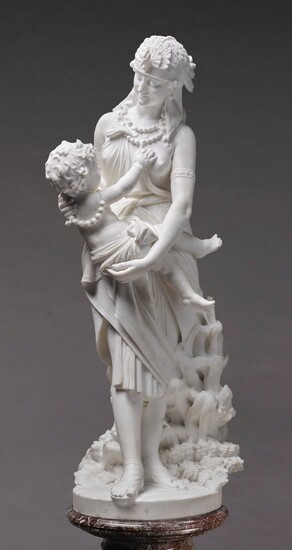ITALIAN THE FINDING OF MOSES, Pietro Bazzanti
1842-1881
Pietro Bazzanti
signed: P. Bazzanti / Firenze
white marble, on a veined red marble pedestal
figure: 150cm., 59in.
pedestal: 82cm., 32¼in.
Provenance:
This exceptional marble group encapsulates the romantic historicist movement in late 19th century Italian sculpture. Though representing a religious subject, the marble is imbued with the playful exuberance found in genre sculpture, lending it a unique appeal.
The Finding of Moses is recounted in the Book of Exodus in the Old Testament. Following the Pharao’s order that all Israelite-born boys must be thrown into the Nile, Moses’ mother concealed her son for some time before eventually committing him to the river in a papyrus basket. While bathing in the river, the Pharao’s daughter chanced upon the basket and discovered the baby inside. Taking pity on him, she conversed with Moses’ sister, Miriam, who had looked on her brother’s fate by the riverbank. Miriam suggested having the child reared by her mother on the princess’s behalf. When the child grew older, he was given to the Pharao’s daughter as her adoptive child.
Bazzanti’s rendering of the subject in marble focuses on the tender maternal connection formed between the Pharao’s daughter and the abandoned infant as she takes him in her arms. Instantly trusting of the princess, the child curiously touches her necklace while returning her benevolent smile. It is this affectionate interaction between the two Old Testament figures that makes the narrative tangible to the contemporary viewer, despite its overtly exotic setting: the princess is clad in luxurious drapes and jewels, while exhibiting an elaborate vulture headdress, which became an attribute of Egyptian royal women in the Old Kingdom. The sculptor’s skill is showcased beautifully in the carving of this exotic garment, which extends in a tuft of feathers at the back. The Nilotic setting is evoked by the abundant reeds resting against the woman’s legs, and the foam of the current below.
Pietro Bazzanti was a central figure in the production of Florentine sculpture at the
end of the 19th century. His studio, which would become known as the Galleria Bazzanti, was established in 1822 and remains open today. Specialising in sculpture after the antique, as well as original allegorical and genre pieces, Bazzanti’s studio attracted accomplished sculptors such as Cesare Lapini, Ferdinando Vichi and Guglielmo Pugi, all of whom executed works bearing the inscription: Galleria Bazzanti. Its signature indicates, however, that the present group is an autograph work by Pietro Bazzanti himself and is likely to date from the 1870s. During this decade Bazzanti participated successfully in international exhibitions, including in London in 1874, and in Philadelphia in 1876.
RELATED LITERATURE
A. Panzetta, Nuovo dizionario degli scultori italiani dell'ottocento e novecento, Turin, 2003, vol. 1, p. 78
View it on
Estimate
Time, Location
Auction House
1842-1881
Pietro Bazzanti
signed: P. Bazzanti / Firenze
white marble, on a veined red marble pedestal
figure: 150cm., 59in.
pedestal: 82cm., 32¼in.
Provenance:
This exceptional marble group encapsulates the romantic historicist movement in late 19th century Italian sculpture. Though representing a religious subject, the marble is imbued with the playful exuberance found in genre sculpture, lending it a unique appeal.
The Finding of Moses is recounted in the Book of Exodus in the Old Testament. Following the Pharao’s order that all Israelite-born boys must be thrown into the Nile, Moses’ mother concealed her son for some time before eventually committing him to the river in a papyrus basket. While bathing in the river, the Pharao’s daughter chanced upon the basket and discovered the baby inside. Taking pity on him, she conversed with Moses’ sister, Miriam, who had looked on her brother’s fate by the riverbank. Miriam suggested having the child reared by her mother on the princess’s behalf. When the child grew older, he was given to the Pharao’s daughter as her adoptive child.
Bazzanti’s rendering of the subject in marble focuses on the tender maternal connection formed between the Pharao’s daughter and the abandoned infant as she takes him in her arms. Instantly trusting of the princess, the child curiously touches her necklace while returning her benevolent smile. It is this affectionate interaction between the two Old Testament figures that makes the narrative tangible to the contemporary viewer, despite its overtly exotic setting: the princess is clad in luxurious drapes and jewels, while exhibiting an elaborate vulture headdress, which became an attribute of Egyptian royal women in the Old Kingdom. The sculptor’s skill is showcased beautifully in the carving of this exotic garment, which extends in a tuft of feathers at the back. The Nilotic setting is evoked by the abundant reeds resting against the woman’s legs, and the foam of the current below.
Pietro Bazzanti was a central figure in the production of Florentine sculpture at the
end of the 19th century. His studio, which would become known as the Galleria Bazzanti, was established in 1822 and remains open today. Specialising in sculpture after the antique, as well as original allegorical and genre pieces, Bazzanti’s studio attracted accomplished sculptors such as Cesare Lapini, Ferdinando Vichi and Guglielmo Pugi, all of whom executed works bearing the inscription: Galleria Bazzanti. Its signature indicates, however, that the present group is an autograph work by Pietro Bazzanti himself and is likely to date from the 1870s. During this decade Bazzanti participated successfully in international exhibitions, including in London in 1874, and in Philadelphia in 1876.
RELATED LITERATURE
A. Panzetta, Nuovo dizionario degli scultori italiani dell'ottocento e novecento, Turin, 2003, vol. 1, p. 78



